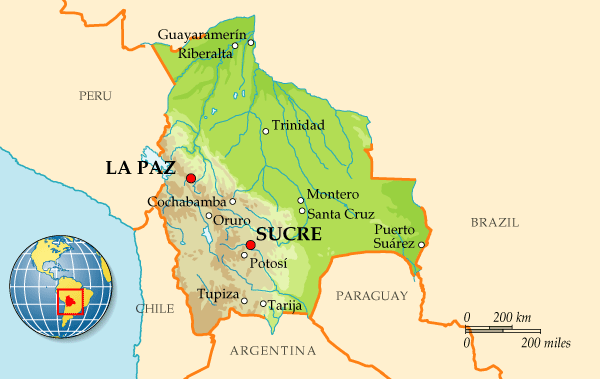Population : 8 445 134 habitants (est. 2002)
Pays voisins : Pérou, Brésil, Paraguay, Argentine, Chili
Densité : 7.69 hab./km²
Superficie : 1 098 581 km²
Capitale : La Paz
Principales villes : Cochabamba, Oruro, Santa Cruz, Sucre, Potosi
Point culminant : Cerro Illimani 6 882 m.
Langue(s) parlée(s) : Quechua, Espagnol, Aymara
Langue(s) officielle(s) : Quechua, Espagnol, Aymara
Monnaie : Boliviano
Fête nationale : 6 août


Pays voisins : Pérou, Brésil, Paraguay, Argentine, Chili
Densité : 7.69 hab./km²
Superficie : 1 098 581 km²
Capitale : La Paz
Principales villes : Cochabamba, Oruro, Santa Cruz, Sucre, Potosi
Point culminant : Cerro Illimani 6 882 m.
Langue(s) parlée(s) : Quechua, Espagnol, Aymara
Langue(s) officielle(s) : Quechua, Espagnol, Aymara
Monnaie : Boliviano
Fête nationale : 6 août

Bolivia , officially known as the Plurinational State of Bolivia , is a landlocked country located in central South America. It is bordered by Brazil to the north and east, Paraguay and Argentina to the south, Chile to the southwest, and Peru to the west.
Prior to European colonization, the Andean region of Bolivia was a part of the Inca Empirethe largest state in Pre-Columbian America. The conquistadors took control of the region in the 16th century. During most of the Spanish colonial period, this territory was known as Upper Peru and was under the administration of the Viceroyalty of Peru, which included most of Spain's South American colonies, although the area enjoyed substantial autonomy under the jurisdiction of the Royal Court of Charcas. After declaring independence in 1809, 16 years of war followed before the establishment of the Republic, named for Simón Bolívar, on 6 August 1825. Bolivia has struggled through periods of political instability and economic woes.
Bolivia is a democratic republic that is divided into nine departments. Its geography is varied from the peaks of the Andes in the West, to the Eastern Lowlands, situated within the Amazon Basin. It is a developing country, with a Medium Human Development Index score, and a poverty level of 53%. Its main economic activities include agriculture, forestry, fishing, mining, and manufacturing goods such as textiles, clothing, refined metals, and refined petroleum. Bolivia is very wealthy in minerals, especially tin. Bolivia has gained global attention for its 'Law of the Rights of Mother Earth', one of the unique laws in the world that accord nature the same rights as humans.
The Bolivian population, estimated at 10 million, is multiethnic, including Amerindians, Mestizos, Europeans, Asians and Africans. The main language spoken is Spanish, although the Guarani, Aymara and Quechua languages are also common and all four, as well as 34 other indigenous languages, are official. The large number of different cultures within Bolivia has contributed greatly to a wide diversity in fields such as art, cuisine, literature, and music.





